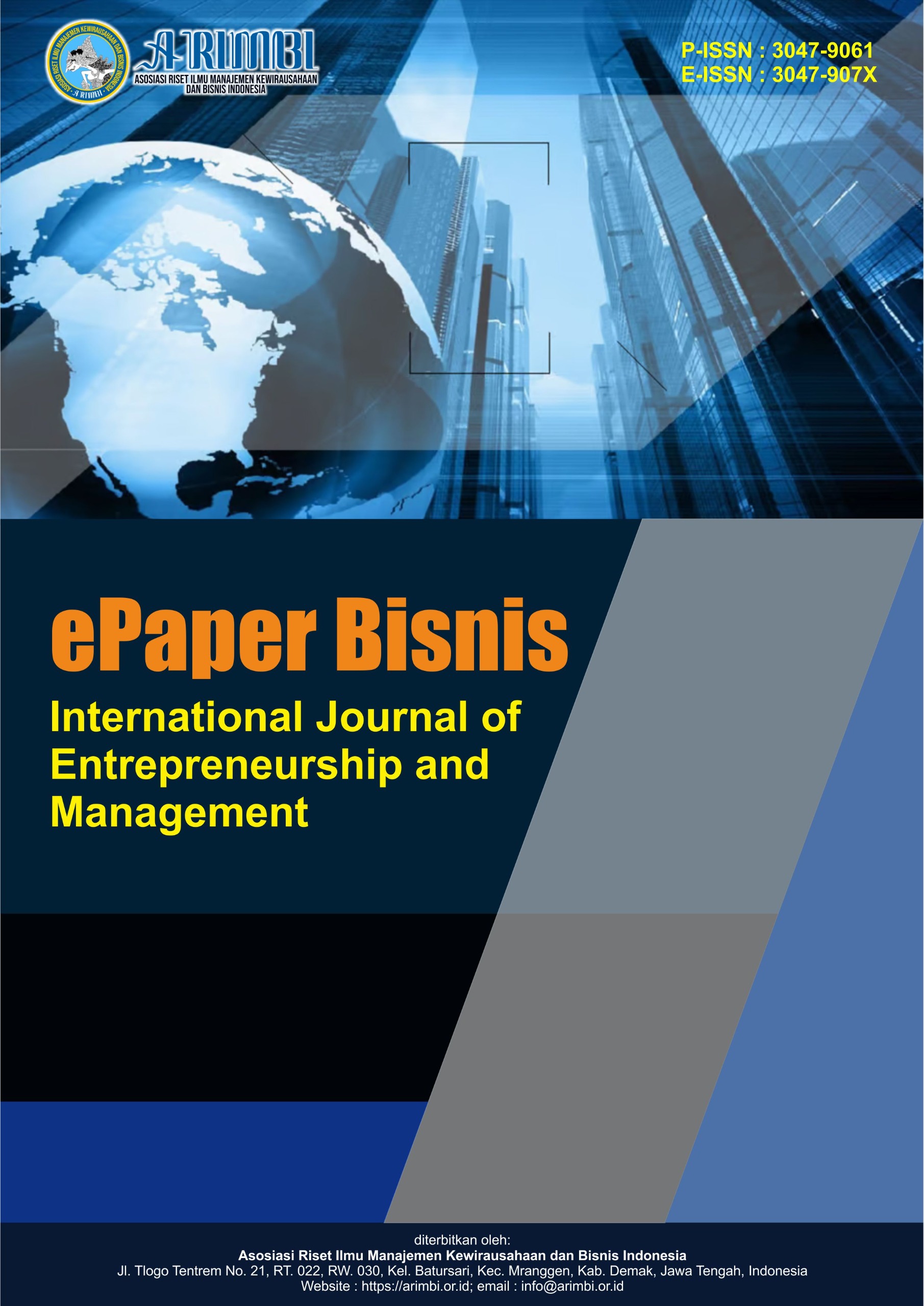The Influence of Social Assistance on Reducing Extreme Poverty in the Social Services of Serdang Bedagai District
DOI:
https://doi.org/10.61132/epaperbisnis.v2i1.288Keywords:
Poverty, Services, Social, ExtremeAbstract
Social structures always show complex categorization. Wealth and poverty are not only seen as the result of functional interactions in society, but a continuing social dialectic understood. This article explores the social life of beggar communities, focusing primarily on the development of the stigma they face from one side of society, and their efforts to exploit it poverty situation as social capital, as work done regularly to continue life. The research method used here is qualitative with a descriptive ap-proach
Downloads
References
Asian Development Bank. (2019). Strong domestic demand to keep Indonesia’s growth on track. Asian Development Bank. https://www.adb.org/news/strong-domestic-demand-keep-indonesias-growthtrack-adb
Baker, S. R., Farrokhnia, R. A., Meyer, S., Pagel, M., & Yannelis, C. (2020). How does household spending respond to an epidemic? Consumption during the 2020 COVID-19 pandemic. Review of Asset Pricing Studies, 10(4), 834–862. https://doi.org/10.1093/rapstu/raaa009
Barrientos, A. (2019). The role of social assistance in reducing poverty and inequality in Asia and the Pacific. ADB Sustainable De-velopment Working Paper Series, 62, 28. https://doi.org/10.22617/WPS190423-2
BPS Jawa Timur. (2020). Profil kemiskinan di Jawa Timur Maret 2020. Berita Resmi Statistik, 40, 1–8.
BPS. (2020). Profil kemiskinan di Indonesia Maret 2020. Berita Resmi Statistik.
BPS. (2021). Pertumbuhan ekonomi Indonesia triwulan IV-2020. Www.Bps.Go.Id, 13, 12. https://www.bps.go.id/pressrelease/2021/02/05/1811/ekonomi-indonesia-2020-turun-sebesar-2-07-persen--c-to-c-.html
Cutter, S. L., Boruff, B. J., & Shirley, W. L. (2003). Social vulnerability to environmental hazards. Social Science Quarterly, 84(2), 242–261. https://doi.org/10.1111/1540-6237.8402002
Domri, D., Ridwan, R., & Jaya, M. (2019). Efektivitas program keluarga harapan dalam meningkatkan kesejahteraan masyarakat. Jurnal Politik dan Pemerintahan Daerah, 1–16.
Hosmer, D. W., & Lemeshow, S. (2000). Applied logistic regression (2nd ed.). John Wiley & Sons.
Hummell, B. M. de L., Cutter, S. L., & Emrich, C. T. (2016). Social vulnerability to natural hazards in Brazil. International Journal of Disaster Risk Science, 7(2), 111–122. https://doi.org/10.1007/s13753-016-0090-9
Kemensos RI. (2019). Program keluarga harapan (PKH). https://kemensos.go.id/program-keluarga-harapanpkh
Kemensos RI. (2021). Kenali lebih dekat program bantuan pangan non tunai. Kemensos.Go.Id. https://kemensos.go.id/uploads/topics/15664651387355.pdf
Kominfo Jatim. (2021). Lima kabupaten di Jatim jadi pilot project percepatan pengentasan kemiskinan ekstrem. Dinas Komunikasi dan Informatika Provinsi Jawa Timur. http://kominfo.jatimprov.go.id/read/umum/lima-kabupaten-di-jatim-jadi-pilot-project-percepatanpengentasan-kemiskinan-ekstrem
McCord, A. (2010). The impact of the global financial crisis on social protection in developing countries. International Social Security Review, 63(2), 31–45. https://doi.org/10.1111/j.1468-246X.2010.01360.x
Mokomane, Z. (2012). Types of good practices focusing on family poverty reduction and social exclusion.
Pemprov Jatim. (2021). Radar Bansos Jatim. https://radarbansos.jatimprov.go.id/
Poverty & Equity Brief East Asia & Pacific. (2019). Poverty and equality brief. https://databank.worldbank.org/data/download/poverty/33EF03BB-9722-4AE2-ABC7-AA2972D68AFE/FM2019/Global_POVEQ_CHN.pdf
Prawoto, N., Purnomo, E. P., & Az, Z. A. (2020). The impacts of COVID-19 pandemic on socio-economic mobility in Indonesia. International Journal of Economics and Business Administration, VII(3), 57–71.
Rahman, M. A. (2013). Household characteristics and poverty: A logistic regression analysis. The Journal of Developing Areas, 47(1), 303–317. http://muse.jhu.edu/journals/jda/summary/v047/47.1.rahman.html
Siddique, A. B., Haynes, K. E., Kulkarni, R., & Li, M. H. (2022). Regional poverty and infectious disease: Early exploratory evidence from the COVID-19 pandemic. Annals of Regional Science. https://doi.org/10.1007/s00168-022-01109-x
Sirusa BPS. (2022). Garis kemiskinan. https://sirusa.bps.go.id/sirusa/index.php/indikator/50
Suryahadi, A. (2019). Dampak program bantuan tunai terhadap kemiskinan dan ketimpangan serta respon perilaku penerima. Jakarta: The SMERU Research Institute.
Suryahadi, A., al Izzati, R., & Suryadarma, D. (2020). The impact of COVID-19 outbreak on poverty: An estimation for Indonesia (Draft). SMERU Working Paper, April, 1–20. http://smeru.or.id/en/content/impact-covid-19-outbreak-poverty-estimation-indonesia
TNP2K. (2021). Indikator kesejahteraan sosial utama, 35 kabupaten fokus penanggulangan kemiskinan ekstrem tahun 2021. Booklet TNP2K, Sekretariat Wakil Presiden RI, September. https://cloud.tnp2k.go.id/index.php/s/KzYSJtreSRGXMoD#pdfviewer
Todaro, M. P., & Smith, S. C. (2015). Economic development (12th ed.). PEARSON.
United Nations. (2022, April 28). Ending poverty. Retrieved April 28, 2022, from United Nations: https://www.un.org/en/global-issues/ending-poverty
World Bank. (1990). World development report 1990. https://www.jstor.org/stable/1154433
World Bank. (2021). COVID-19 to add as many as 150 million extreme poor by 2021. https://www.worldbank.org/en/news/press-release/2020/10/07/covid-19-to-add-as-many-as-150-millionextreme-poor-by-2021
Downloads
Published
How to Cite
Issue
Section
License
Copyright (c) 2025 ePaper Bisnis : International Journal of Entrepreneurship and Management

This work is licensed under a Creative Commons Attribution-ShareAlike 4.0 International License.




